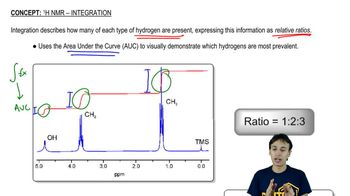Here are the essential concepts you must grasp in order to answer the question correctly.
NMR Multiplicity
NMR multiplicity refers to the splitting of NMR signals into multiple peaks due to spin-spin coupling between non-equivalent hydrogen atoms. The number of peaks in a signal is determined by the n+1 rule, where n is the number of neighboring hydrogen atoms. Understanding multiplicity is crucial for interpreting NMR spectra and identifying molecular structures.
Recommended video:
Sextet in NMR
A sextet in NMR spectroscopy is a signal split into six peaks. This occurs when a hydrogen atom is coupled with five equivalent neighboring hydrogen atoms (n=5), resulting in a 6-peak pattern. The intensity ratio of these peaks typically follows Pascal's triangle, specifically 1:5:10:10:5:1 for a sextet, reflecting the statistical distribution of spin states.
Recommended video:
Pascal's Triangle in NMR
Pascal's Triangle is used in NMR to predict the relative intensities of peaks in a multiplet. Each row of the triangle corresponds to the coefficients of the binomial expansion, which represent the intensity ratios of the peaks. For example, a sextet's intensity ratio is derived from the sixth row, providing a clear pattern for interpreting complex splitting in NMR spectra.
Recommended video:
 Verified step by step guidance
Verified step by step guidance Verified video answer for a similar problem:
Verified video answer for a similar problem:



 8:06m
8:06m